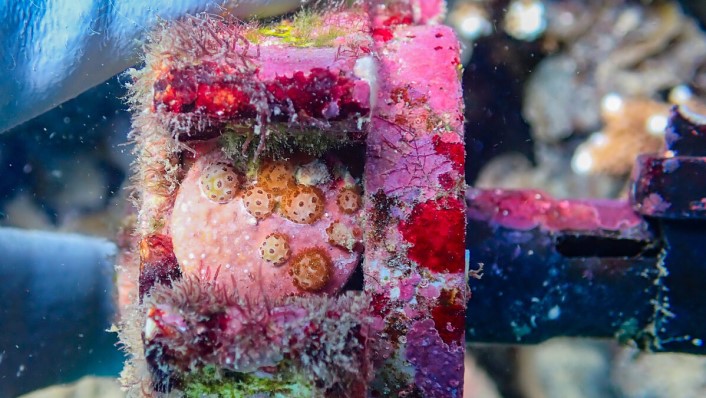One of the greatest challenges of reef restoration on the Great Barrier Reef is its vast size. AIMS and its partners are meeting this challenge by bringing together the latest science, innovative technologies, and people power.
The Pilot Deployments Program (PDP) is the operational testing phase of the Reef Restoration and Adaptation Program (RRAP). It is dedicated to understanding and improving the ecological efficacy and feasibility of using reef restoration tools at scale on the Great Barrier Reef.
The Pilot Deployments Program aims to test the end-to-end delivery of millions of young corals, settled on large areas of reefs to help fast track their recovery. This will amplify the Reef’s own restorative phenomenon: mass coral spawning.
This three-year program is delivered by AIMS alongside RRAP partners, and funded by the Australian Government’s Reef Trust. The Great Barrier Reef Foundation Reef Restoration Fund also provides philanthropic funding.
The initial years of RRAP focused on the research and development of technologies and scientific knowledge required for reef restoration. The Pilot Deployments Program explores how to put this into practice at scale, taking into account feasibility, efficacy, safety and governance. Pending trial outcomes, the insights gained here will support the potential deployment (as required) of large-scale, integrated reef restoration and adaptation interventions.
Why do we need reef restoration?
Climate change is the greatest threat to reefs worldwide, and reducing emissions is critical to ensuring the future of coral reefs around the world.
But emissions reductions alone will not safeguard the Great Barrier Reef and coral reefs around the globe. Ocean warming to date has already been damaging, and further warming is locked in. Reefs’ natural recovery processes are now severely challenged.
Additional options are needed to give the Great Barrier Reef the best chance to survive and prosper in a warmer future, and extend the time available for global emissions reduction. Therefore, in tandem with global action on emissions and effective Reef management, a new toolbox of scalable interventions to restore reefs are required.
How does the Pilot Deployments Program work?
As the tools developed by RRAP become ready, they are transitioned into the Pilot Deployments Program for real-world trials. Lessons learned from these field trials help the RRAP research teams to refine, adapt, or scale technologies, allowing continuous improvement and accelerating development.
Initially, two types of restoration interventions will undergo pilot deployment on the Reef. These are the seeding of coral larvae and the seeding of corals propagated by aquaculture. Both were selected for their technological readiness and modelling of their potential benefits for the Reef.
Monitoring pilot deployments
Monitoring of the young corals after deployments is essential to understand the efficacy of the methods, and inform future iterations. Monitoring of sites will be conducted at multiple scales, and be carried out by science teams, industry and participating Traditional Owner groups.
Manual and tech-based monitoring approaches such as ReefScan and photogrammetry will be used across the sites, with some surveys continuing after the three-year program concludes.
Device locations are geotagged and monitored in 6-month and 1-year intervals to measure retention, coral growth and survival. This data will help assess conservation aquaculture and inform coral resilience research.
People power behind the Pilot Deployments Program
A key practical part of scaling up reef restoration is to empower local people and industries, by building skills, capacity and partnerships.
One way to do this is by providing training in the advanced skills of reef restoration, with the intention that these skills will become increasingly valuable as reef restoration activities expand in the future.
In 2025, the Pilot Deployments Program established a Panel of Providers to deliver specific services and solutions over a three-year period. This includes coral seeding, monitoring and data collection. The Panel of Providers has Traditional Owner representatives, as well as tourism and commercial reef operators, and members of the coral collection and aquarist industry.
Traditional Owners
Traditional Owners hold important cultural and spiritual connections to Country, including sea Country on the Great Barrier Reef. These connections power deep knowledge and care for the Reef, and inherent rights and responsibility for its future.
The Pilot Deployments Program works closely with Indigenous communities. Free, prior and informed consent is obtained through Traditional Owner engagement before any Pilot Deployments Program activities.
For example, the AIMS-led Indigenous Futures Project works in partnership with Indigenous Ranger groups and the Pilot Deployments Program. Its goal is to empower Traditional Owners to lead in caring for sea Country through reef restoration techniques. A pilot group of Indigenous Rangers are being trained in advanced skills for reef interventions, enabling them to lead these activities within their ranger groups for the future of sea Country when and where required.
Technological advances for Pilot Deployments Program
Several technologies have been pioneered and refined for use in Pilot Deployments Program operations. Technological advances will continue based on feedback from early Pilot Deployments Program data. Some examples of technologies which have already emerged include:
Management
The innovative approaches being developed within the RRAP and the Pilot Deployments Program contribute to a toolbox of options for future management needs. It is critical they are developed with this end-use in mind.
Pilot Deployments Program activities align with Reef protection objectives, regulations and permitting processes from the Reef Authority and the Queensland Department of Environment, Tourism, Science and Innovation (DETSI).
AIMS collaborates with both regulatory bodies to codesign and implement the trials, and continue R&D.
The Pilot Deployments Program is funded by the Australian Government’s Reef Trust, and led by the Australian Institute of Marine Science. It is part of the Reef Restoration and Adaptation Program, funded by the partnership between the Reef Trust and the Great Barrier Reef Foundation.








